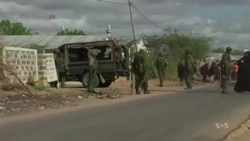Authorities in Kenya are moving the bodies of many of the students killed by Islamist militants at an eastern university to the capital for identification.
Families gathered in Nairobi Friday following Thursday's attack at Garissa University College, which left 148 people dead as well as the four attackers. Relatives formed lines outside of a mortuary as they waited for news of the missing.
The Kenyan government is offering a $220,000 reward for an al-Shabab member in connection with the attacks: Mohammed Mohamud Kuno, who already is on a government watch list. He is suspected to be al-Shabab's chief for external operations against Kenya.
The attack Thursday at Garissa University College is the worst in Kenya since the 1998 bombing of the U.S. Embassy by al-Qaida. The al-Shabab attackers stormed the campus before dawn Thursday and began shooting indiscriminately. Witnesses say the gunmen later targeted Christians and freed some Muslims.
Interior Minister Joseph Nkaissery said the four gunmen had explosives strapped to their bodies and blew up "like bombs."
U.S. President Barack Obama expressed "horror and sadness" over the attack. The White House said he called Kenyan President Uhuru Kenyatta Friday to express his condolences. It said he also reiterated his plans to visit Nairobi in July.
Kenyan security forces battled the militants for 15 hours and rescued more than 500 students before fatally shooting the attackers.
A Kenyan member of parliament, Mohamed Dahiye Duale, told VOA's Somali service that at least 143 of those killed were students. He said there is strong information that the attackers came from refugee camps in Kenya.
He said authorities believe the attackers came by foot on the day of the attack and had used a taxi which is yet to be located.
Claim of revenge
Al-Shabab said the attack was revenge for Kenyan military action inside neighboring Somalia, where the Islamist militant group is based.
Somalia's President Hassan Sheikh Mohamud called for greater security cooperation with Kenya, offering his condolences after what he described as a "barbaric" attack. He said Friday that the killings underscore the need to eliminate al-Shabab's "menace" from the region.
Some witnesses say the university attackers were separating Christians from Muslims, taking Christians and some others hostage.
The attack was the most violent in Kenya since the 2013 terrorist strike on Nairobi's Westgate Mall, which killed more than 60 people.
A White House spokesman said the United States condemned Thursday's terrorism against "innocent men and women." He said the U.S. stands with the Kenyan people, who "will not be intimidated by such cowardly attacks."
Pope Francis on Friday condemned the latest attack as "senseless brutality."
Police reinforcements planned
Kenyan President Uhuru Kenyatta told the nation that "this is a moment for everyone throughout the country to be vigilant as we confront and defeat our enemies."
He ordered 10,000 police recruits whose enrollments are still pending to immediately report for training at the police college.
"We as a country have suffered unnecessarily due to a shortage of security personnel," he said. "Kenya badly needs additional officers, and I will not keep the nation waiting."
Al-Shabab is an al-Qaida-linked group that has battled the Somali government and its allies since 2006. The group has attacked targets in Kenya since Nairobi sent troops across the border in 2011.
The University of Nairobi warned its students last week that Kenyan government agencies had intelligence reports indicating al-Shabab was planning an attack on a major university, among other targets. It was not clear if a similar warning was issued in Garissa.









